The British Monarchy at war!
Does little-known archive reveal a long-forgotten poem by ‘The Injured Queen’?
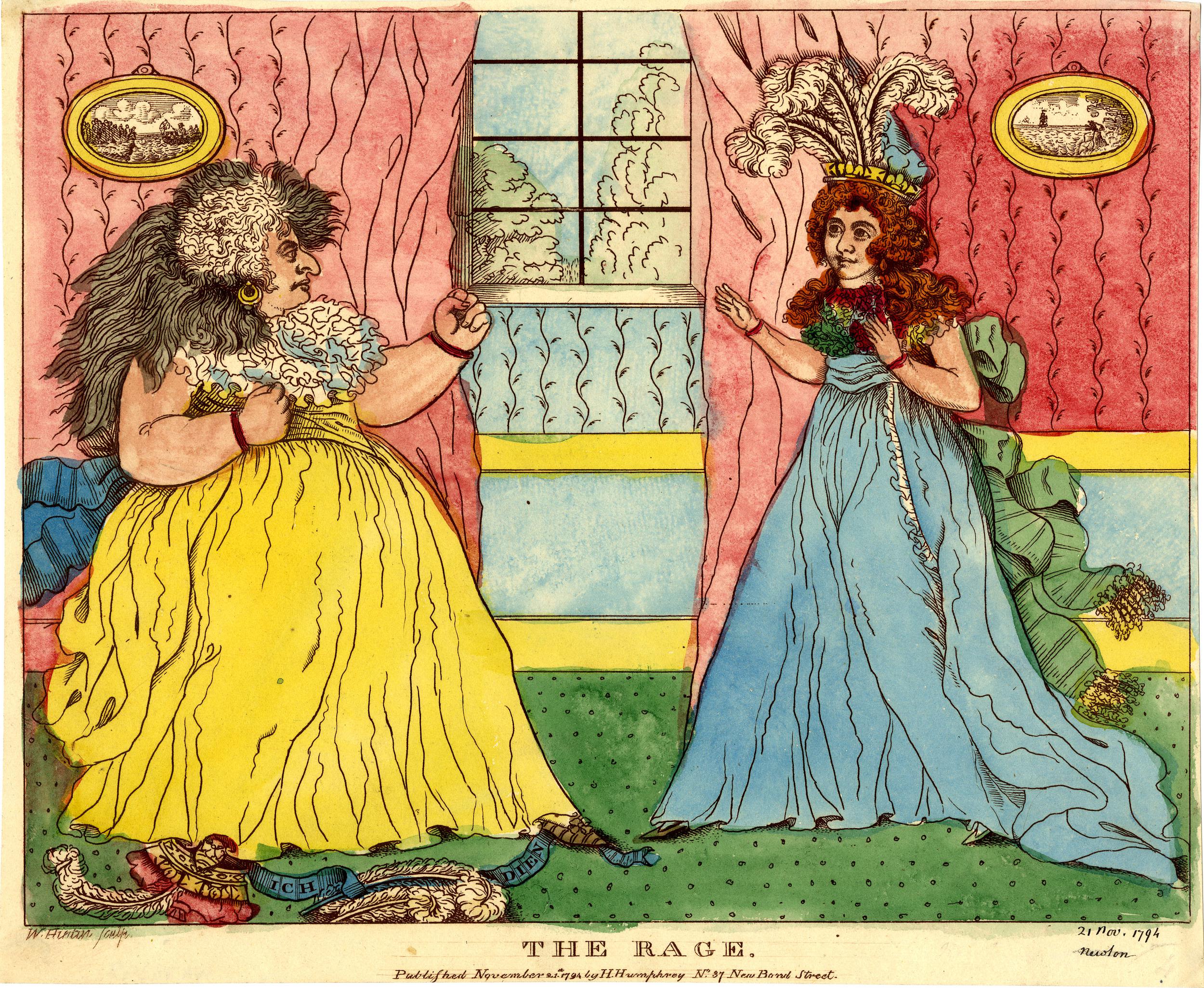
Cambridge University Library is now home to a collection of papers giving an intimate account of the Royal Family in open conflict during its infamous investigation into the Princess of Wales.
A heartbroken poem – possibly composed by a former Queen of England before being lost to history for more than two centuries – is among a recently-acquired archive of private papers which reveal fascinating first-hand insights into the ‘Delicate Investigation’ of 1806 – one of the most scandalous episodes in the history of the UK monarchy.
Caroline of Brunswick, known as ‘The Injured Queen’, may have written the poem while still Princess of Wales as an anguished, heartfelt plea to her husband George, Prince of Wales (later King George IV), while the estranged royal couple were entangled in a bitter and very public dispute over later discredited allegations that Caroline had borne a child out of wedlock.
Their enmity persisted until Caroline’s death in 1821, just weeks after she had been barred from her husband’s and her own Coronation – with the Queen infamously turned away from both Westminster Abbey and Westminster Hall by servants of the King.
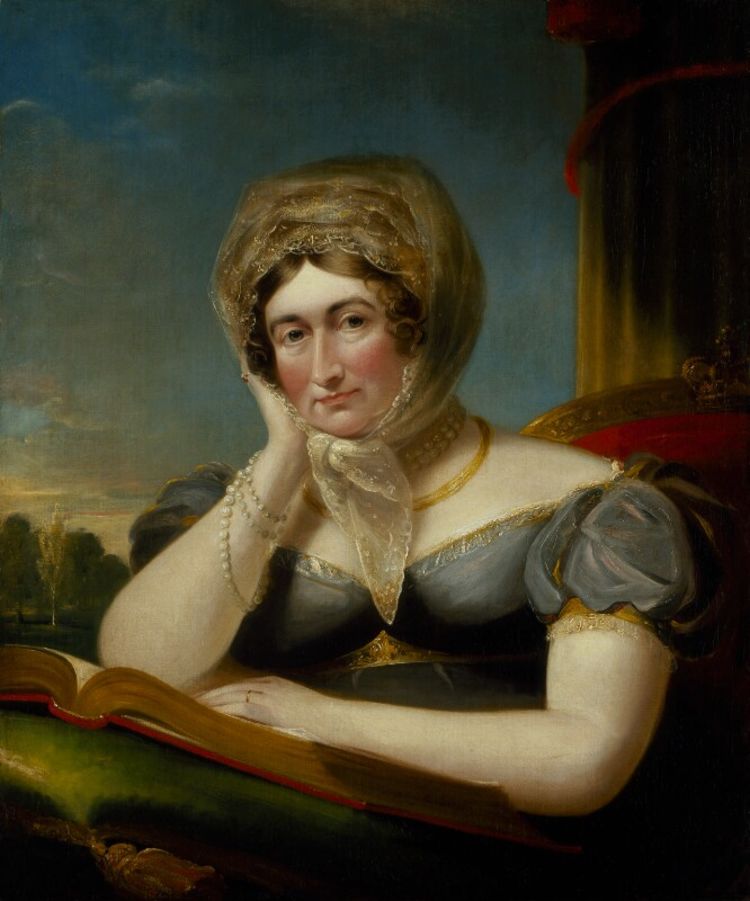
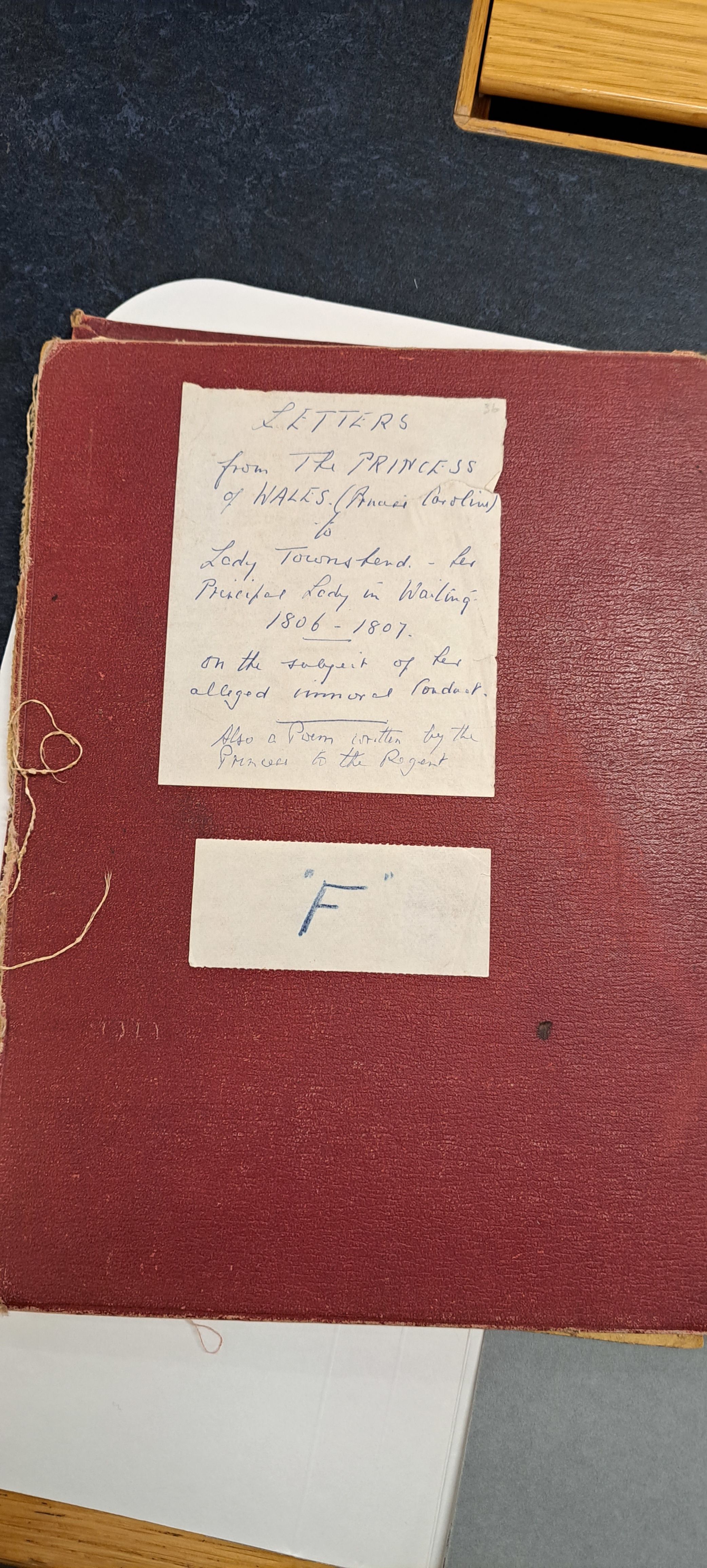
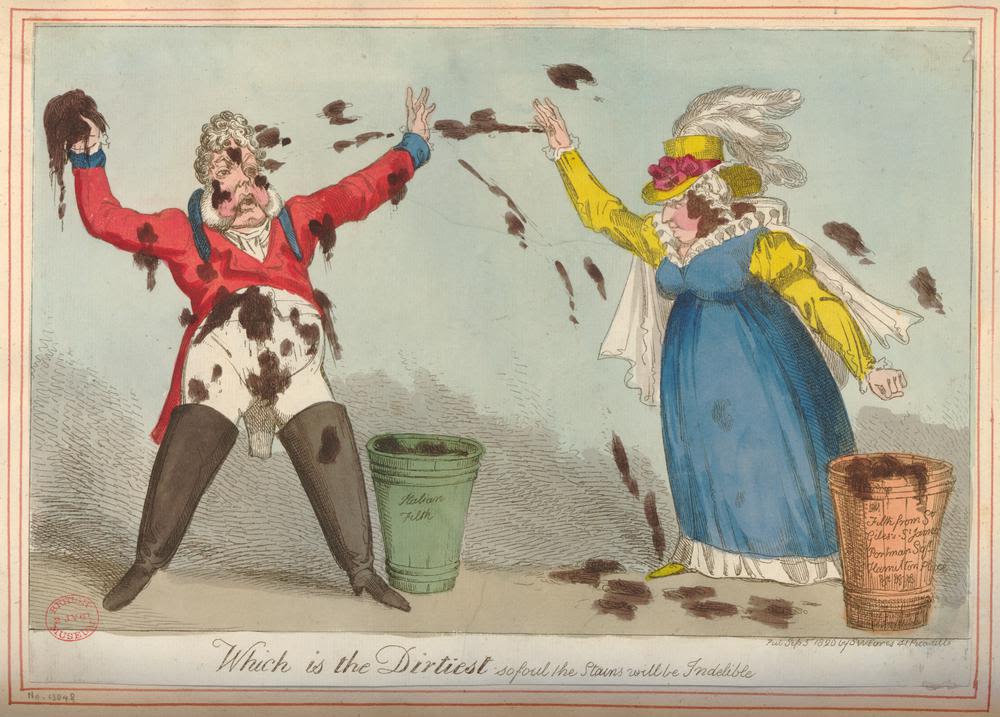

Portrait of Caroline. Circa 1820. Her wedding ring is displayed prominently to emphasise fidelity to marriage vows. Credit: Wikipedia Commons
Portrait of Caroline. Circa 1820.

A cover from the Massy-Beresford archive detailing its contents relating to 'The Delicate Investigation'.
A cover from the Massy-Beresford archive detailing its contents relating to 'The Delicate Investigation'.

Satirical print featuring King George IV and Queen Caroline slinging mud at one another. 'Which is the dirtiest, so foul the stains will be indelible'. Credit: British Museum
Satirical print featuring King George IV and Queen Caroline. 'Which is the dirtiest, so foul the stains will be indelible'. Credit: British Museum
Among archive papers dating from 1806-7, a 48-line poem, entitled To His Royal Highness begins:
“Of Royal lineage, and of spotless fame,
It ill befits me humbly thus to sue;
An injured Princess, justice is my claim,
A helpless woman, pity is my due.
Ah, good my Lord, what is the dire pretence
That draws your high displeasure on my head,
Witness this heart unconscious of offence,
Witness the blameless life I still have led!...”
The manuscript poem and other related papers are part of the Massy-Beresford collection which has been donated to Cambridge University Library by the late Michael Massy-Beresford. It includes many dozens of handwritten letters and contemporary copies of letters from the early 1800s exchanged between Princess Caroline, King George III, and Caroline’s loyal circle of friends and supporters.
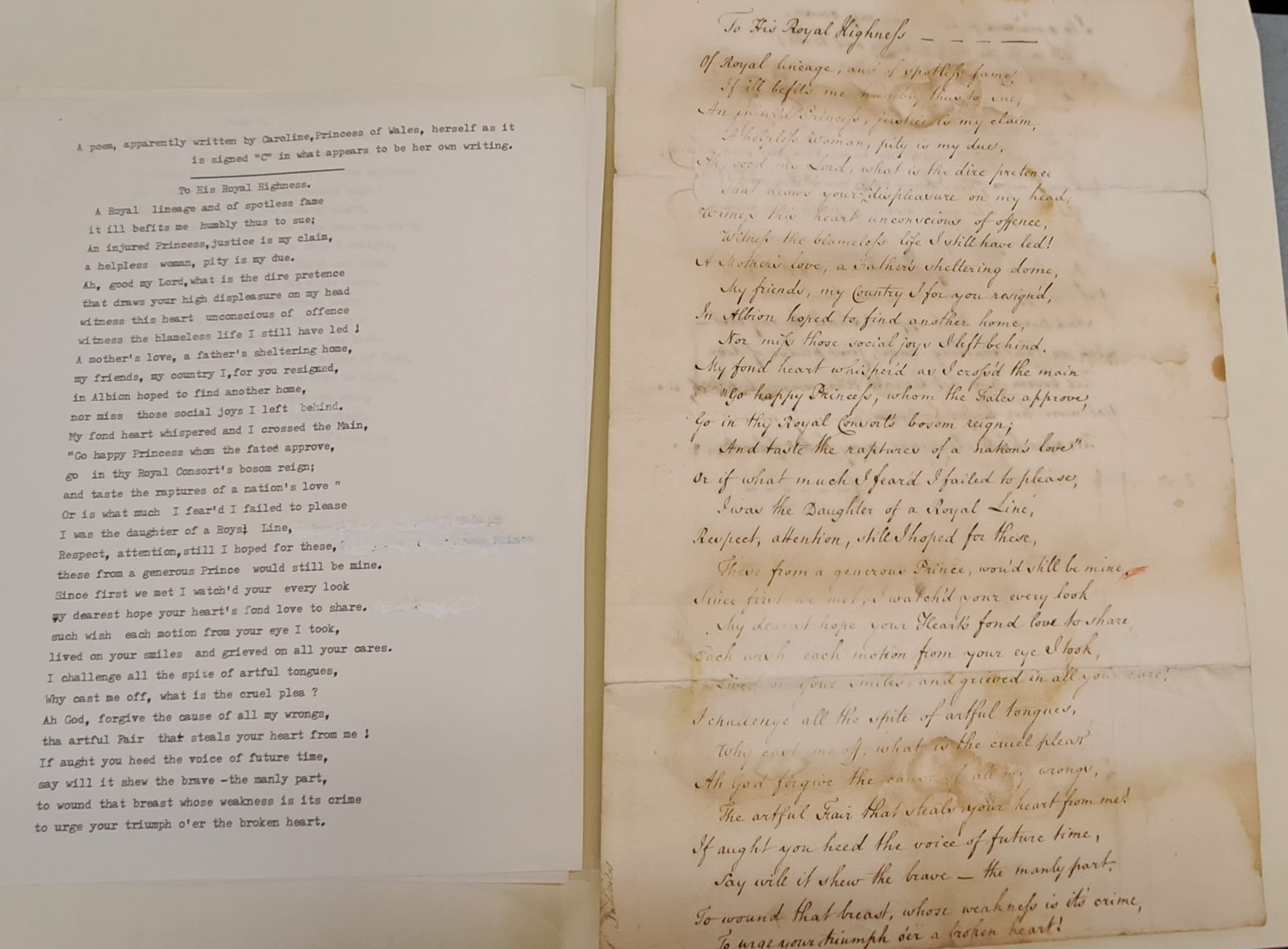
The handwritten poem (right) believed to have been written by Queen Caroline, and a 20th century transcription by a member of the Massy-Beresford family.
The handwritten poem (right) believed to have been written by Queen Caroline, and a 20th century transcription.
Little trace of the poem, which has been in private hands for the past 200 years, can be found in the public record and it appears unknown to modern-day historians and biographers of Caroline and the Regency monarchy. Likewise, the larger Massy-Beresford archive has been almost exclusively unavailable to historians of the Royal Family until now.
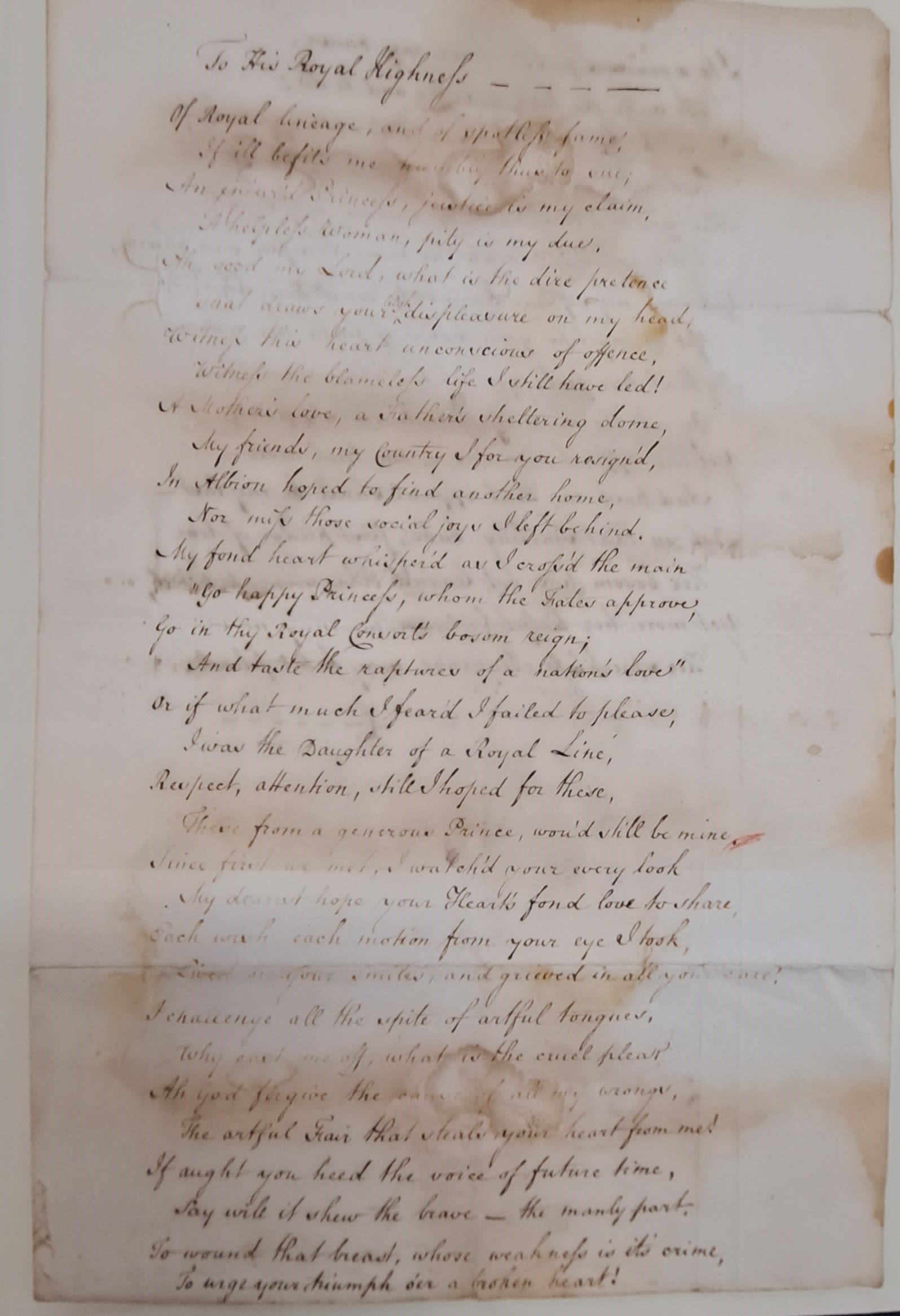
The handwritten poem is now part of the Massy-Beresford archive at Cambridge University Library.
The handwritten poem is now part of the Massy-Beresford archive at Cambridge University Library.
The only known exception appears to be Joanna Richardson’s 1960 volume The Disastrous Marriage, with Richardson given sight of the papers now in Cambridge by their then owner, Brigadier Tristram Massy-Beresford.
“These letters transport us to a febrile period of royal history. The outline of the story is well enough known to historians, but these personal letters – sent directly to and from the Princess and other leading participants – reveal more about the calculations and sensitivities of those most intimately involved. They give scholars insights that can’t be gleaned from the official public record.
“The poem To His Royal Highness is a fascinating mystery. Was it written by Princess Caroline? An anonymous printed version appeared in an obscure publication several years after the Delicate Investigation, and it might be assumed that a hack writer was simply voicing the supposed thoughts of the Princess as a literary device.
“But the discovery of a handwritten copy in these files places the poem much closer to Caroline’s inner circle. The handwritten text differs in several places from the printed version, so the manuscript can’t just have been copied out from the book.
“It’s not in Caroline’s handwriting, but we can see from an interpolated word that it has been copied from somewhere, and it was carefully preserved in the files of the Princess’s confidante Lady Townshend. Was the original source Caroline herself?”
John Wells, Senior Archivist
Cambridge University Library
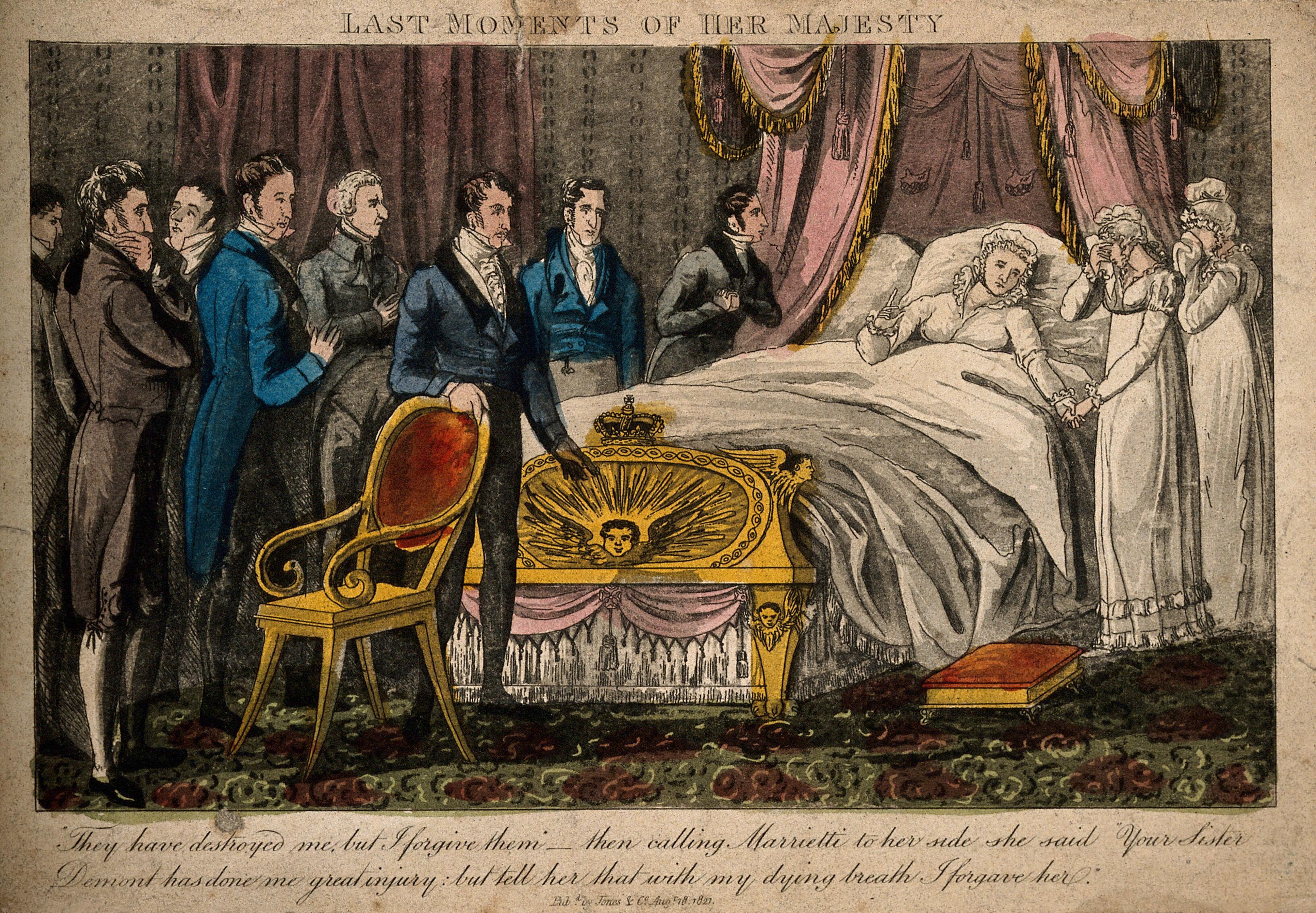
The Massy-Beresford archive lays bare the Princess of Wales’s dismay and anger at the Prince of Wales and the wider Royal Family over her banishment from life at court and potentially treasonous charges of adultery.
The archive also has a copy of the final report and findings into Princess Caroline’s conduct, as well as copies of statements from the Prince of Wales’s star witnesses – Sir John and Lady Douglas, one-time friends of Caroline who alleged that a baby boy adopted by the Princess had in fact been borne by her.
Correspondence relating to the Delicate Investigation in the Library’s collection contains letters between Princess Caroline, future UK Prime Minister Spencer Perceval (who was later assassinated), Lady Anne (Marchioness) Townshend (Mistress of the Robes to Princess Caroline), and Thomas Manby among others.
Manby was a Royal Navy captain accused of having inappropriate relations with Princess Caroline, wife of the adulterous and gambling-addicted Prince of Wales, who waited nearly 60 years to take the throne from his father King George III.
At the time of his marriage to Caroline of Brunswick, George was already secretly and illegally married to his Catholic lover, the twice-widowed commoner Maria Fitzherbert.
"The Massy-Beresford papers contain a fascinating insight into Caroline of Brunswick. In recent years historians have paid a lot of attention to the political aspects of her life, and how the details of her spectacular marital breakdown played out in the press to a captivated public audience.
"The understudied documents in these papers contain correspondence written by Caroline herself and her confidants, during the time of the Delicate Investigation. This collection offers the opportunity to study the not-so-public dimensions of the scandal, especially this earlier investigation in 1806, which has been somewhat eclipsed by the events of 1820.
“The original author (of the poem) isn’t clear- but it’s really interesting it is in a collection with private correspondence. We know that Caroline and her allies were in contact with the radical press; whoever the author was, this document demonstrates how this kind of radical satire was circulating amongst private networks in the upper echelons of Caroline’s correspondence networks.”
Dr Katie Carpenter, Lecturer in Public History at the University of Leeds, and Queen Caroline expert
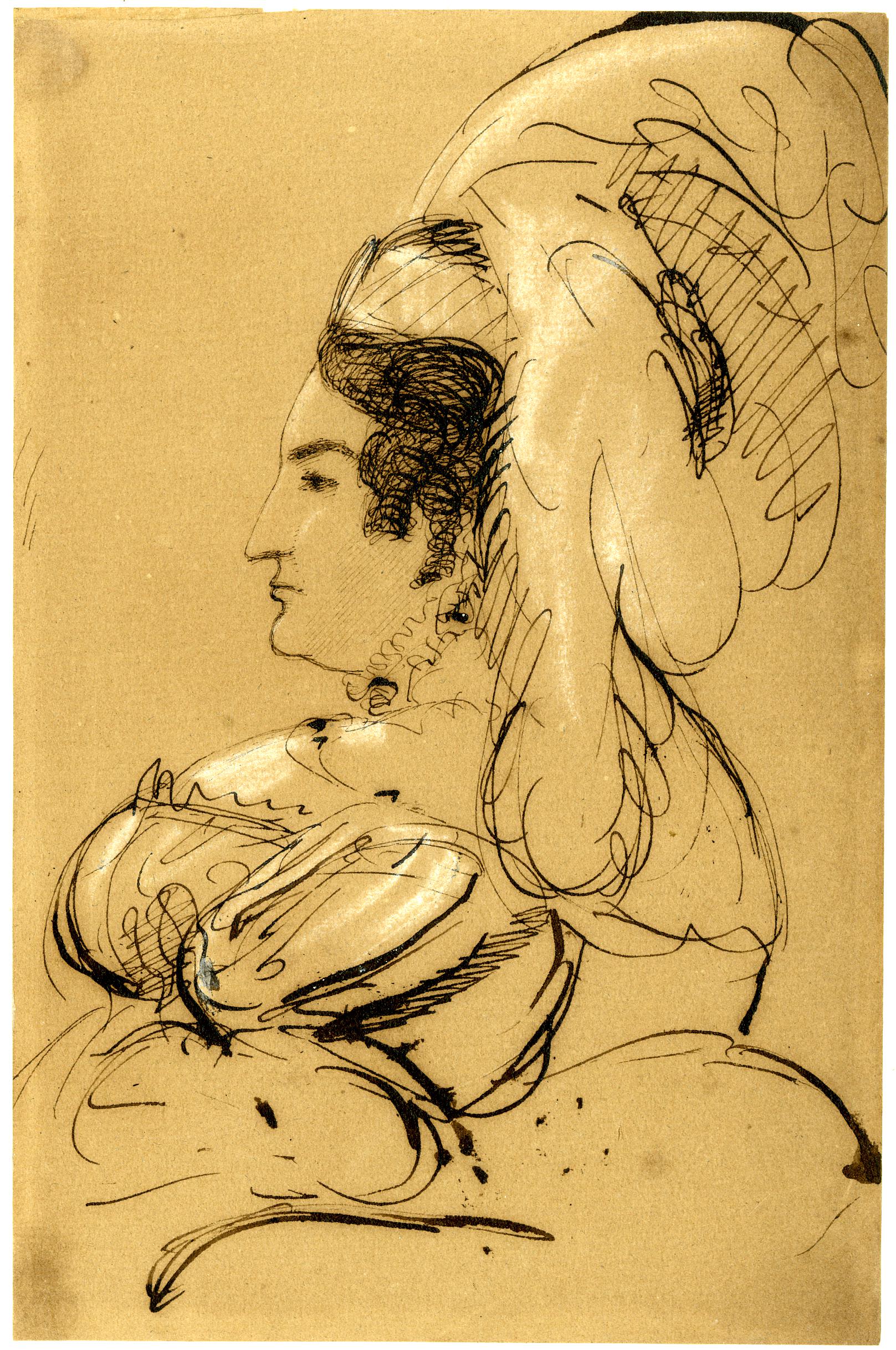
Portrait of Queen Caroline; half-length in profile to left, wearing head-dress with feathers. Credit: British Museum.
Portrait of Queen Caroline; half-length in profile to left, wearing head-dress with feathers. Credit: British Museum.
The Massy-Beresford archive at Cambridge gives astonishing insight into the tormented mind of a Princess of Wales beloved by the British public at a time when the wider monarchy, and her husband most notably, were largely detested. The Prince of Wales was seen as out of touch for his eye-wateringly lavish spending and the huge debts he accumulated via his notoriously extravagant and profligate lifestyle.
The Delicate Investigation letters now held at Cambridge University Library also reveal how much pressure was brought to bear on friends, associates, staff and acquaintances of Caroline, with anonymous letters to her retinue promising lavish rewards for information that might discredit the Princess.
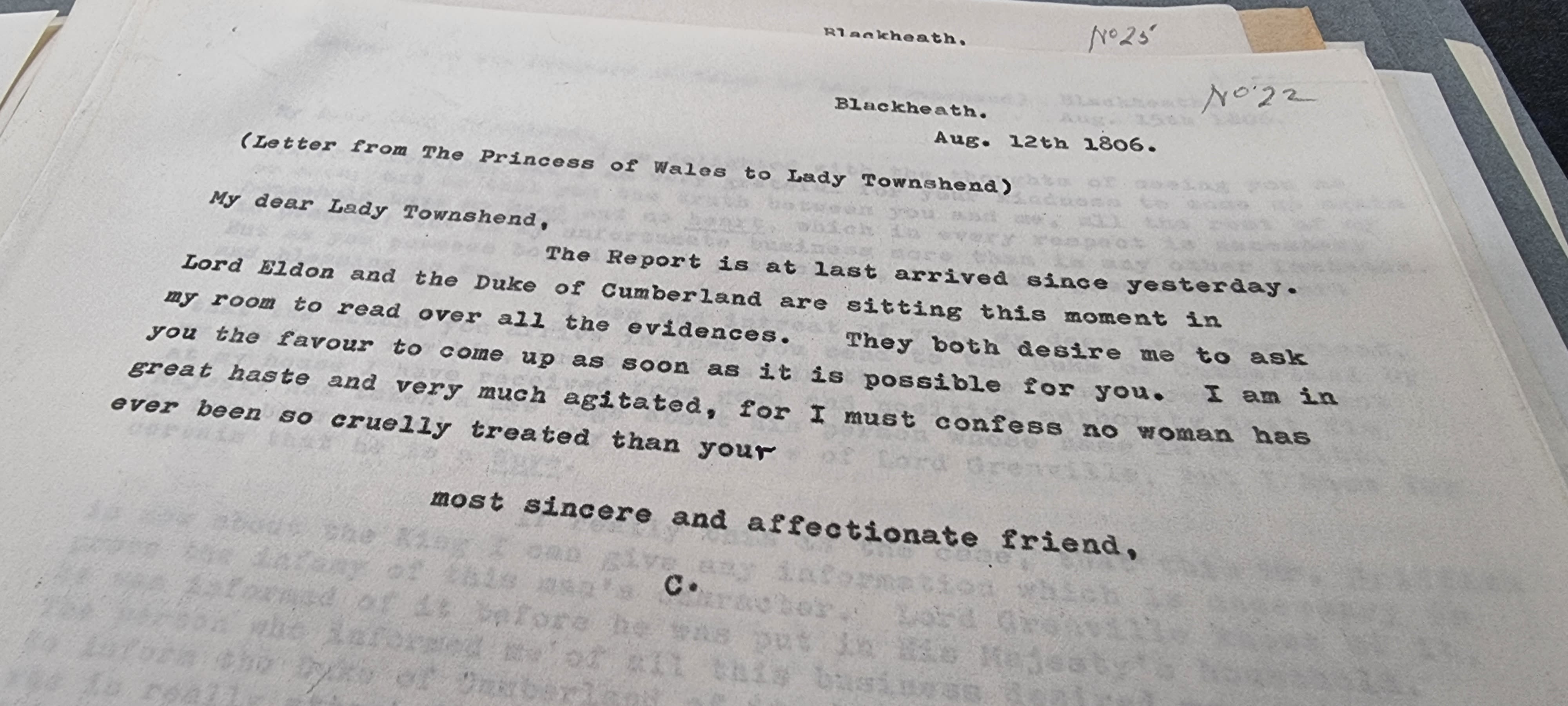
Transcript of a letter written by Princess Caroline to Lady Townshend.
Transcript of a letter written by Princess Caroline to Lady Townshend.
The initially secret investigation was launched in 1806 at the behest of the Prince of Wales, in order to find or contrive evidence of adultery and other crimes that could be used as a pretext for divorce from Caroline. Despite the best efforts of the Prince, Caroline was exonerated of the charges against her, although the final report did chastise the Princess of Wales for some of her alleged conduct with Captain Manby and others.
However, those loyal to George were clearly seeking evidence of wrongdoing by the Princess of Wales several years prior to the investigation becoming public knowledge.
A copy of an anonymous letter in the Cambridge archive, sent to Manby, care of his ship HMS Africaine, around December 1804, reads...
“The writer of this is authorized by a great personage to assure Captain Manby that if he will reveal what has passed between him and a Royal Princess he may name his own reward and have the most solemn promise that his secret shall be kept.
“Any of the Princess’s letters will further answer and no harm on any account shall attend Capt Manby.
“The writer informs Captain Manby that the intimacy and proceedings which took place at Lord Eardley’s, Long Reach, Ramsgate, South End, and other places can be easily proved and that his life may answer the consequences of not disclosing all he knows.”
‘AB’, care of the Star and Garter, Pall Mall.
The missive was followed up a few days later:
“The writer of a former letter, a few days back again addresses Captain Manby to express his surprise at having not received a reply on the subject of a Royal Princess.
“From the same authority an offer of fortune to any amount is pledged to him by making a full discovery of all he knows. A Gentleman will call on Captain Manby in the course of a day or two with the hope of having a confidential conversation on the subject.“
Added Wells: “The material relating to the Delicate Investigation includes letters from the Princess of Wales to Lady Townshend, contemporary copies of letters from the Princess to George III, and letters from Attorney-General (later PM) Spencer Perceval to Lady Townshend, from one of whose descendants this archive has been acquired by Cambridge.
“The Massy-Beresford collection augments the Library’s holdings of political and social papers from the early nineteenth century. In particular it complements our holdings of papers of Spencer Perceval, the Prime Minister shot and killed in the lobby of the House of Commons in 1812.
“As well as papers relating to Caroline of Brunswick, the archive also includes earlier and later generations of Lady Townshend's family, including deeds and estate papers from the sixteenth to the nineteenth centuries; documents relating to an Old Bailey trial for duelling in 1803; and twentieth-century papers including an account of the fall of Singapore in 1942 by the donor's father, Brigadier Tristram Massy-Beresford, with his letters to his wife on release from captivity in 1945.”
